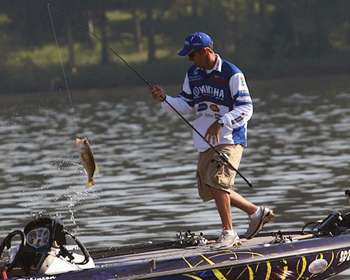
There are certain times when Elite Series pro Marty Robinson likes to fish fast. While the prop on his trolling motor may be barely spinning, the South Carolina pro is burning and turning on the front deck, making long casts and reeling as fast as possible.
When watching this technique in action, it appears to be pure madness. But Robinson explains that there's a reason for the speedy retrieve. "Out here in South Carolina, we have a lot of clear water," he says. "There are pretty much two options to trigger a fish into striking.
You can either slow down and finesse a strike or you can go the opposite way and speed up your retrieve." In many instances, Robinson chooses speed and opts for a weightless Texas rigged Zoom Fluke on the business end.
After making a long cast with a high-speed Abu Garcia Revo 7:1 gear ratio reel, he burns the bait back to the boat, causing the bait to dart and skip across the surface of the water. His goal is to incite an instinctive reaction strike from a wary bass. "By moving the bait really fast, you're not giving the bass a good look at it." he explains. "It's just like dragging a string past a house cat — if you just ease it by, the cat will sit there and look at it.
If you bring it by really fast, instinct takes over and the cat pounces." Robinson's retrieve depends on the conditions. In choppy water, he attempts to make as much commotion on the surface as possible. In calm conditions, he will work the fluke just under or on the surface. "The bass will commit more to the bait when it's windy because it breaks up the surface and doesn't allow them to get a good look at the bait," he explains. It's easy to be skeptical about the legitimacy of this technique, especially when the fluke spends nearly as much time darting out of the water as it spends actually in it, but Robinson cautions not to underestimate the agility of a bass in attack mode.
"The average weekend angler will look at how fast I fish a fluke across the surface and think that there's no way possible a fish could track it down. If you witnessed a bass coming to get it, it would be easy to understand the speed and agility that these fish are capable of," he states. While the way Robinson fishes his fluke in South Carolina, where blueback herring are the dominant forage, may be unique, he points out that using speed to generate strikes is nothing new.
"One of the greatest anglers out there, Kevin VanDam, knows how important speed is to generate strikes," points out Robinson. "He's one of the best at understanding how to make a fish come and get a fast moving bait."
(Provided by Z3 Media)




